SOAR Strategy Implementation and Analysis: Cleveland Clinic Case Study
VerifiedAdded on 2019/11/19
|5
|1065
|147
Case Study
AI Summary
This case study examines the application of the SOAR (Strengths, Opportunities, Aspirations, Results) strategy at the Cleveland Clinic, a non-profit healthcare institution. The analysis begins by outlining the clinic's current situation, including its mission of patient care and medical innovation, its extensive network of employees, and its ranking as a top healthcare provider. The case study then identifies the tasks and obstacles faced by the clinic, such as the need for patient adoption and geographic expansion. It further explores the actions taken by the clinic to address these challenges, including the formation of a clinical management team, the implementation of care pathways, and the transformation of the organization around value. The results of these actions are discussed, highlighting improvements in customer loyalty, departmental organization, and overall functioning, which ultimately contributed to the clinic's high ranking. References to supporting literature are also included.
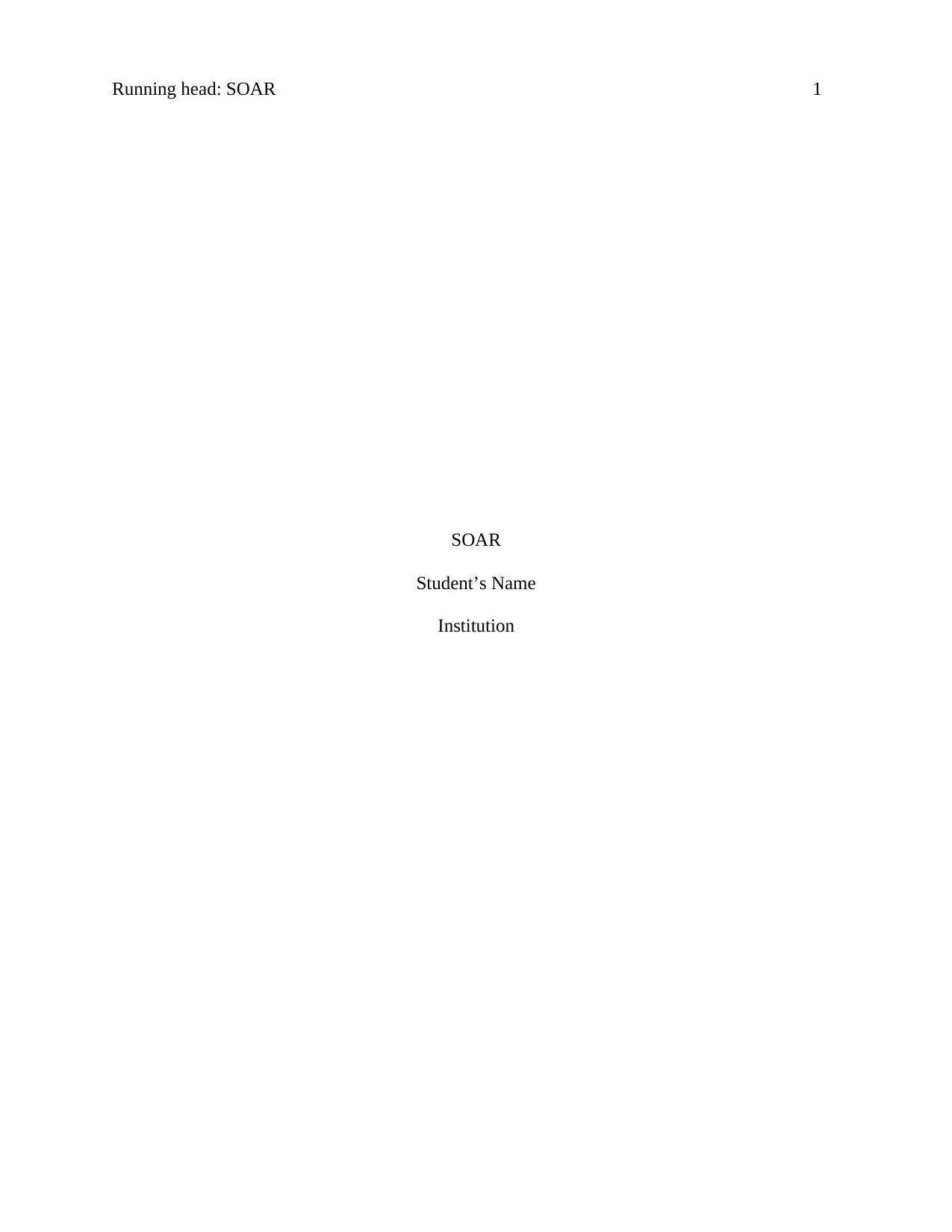
Running head: SOAR 1
SOAR
Student’s Name
Institution
SOAR
Student’s Name
Institution
Paraphrase This Document
Need a fresh take? Get an instant paraphrase of this document with our AI Paraphraser
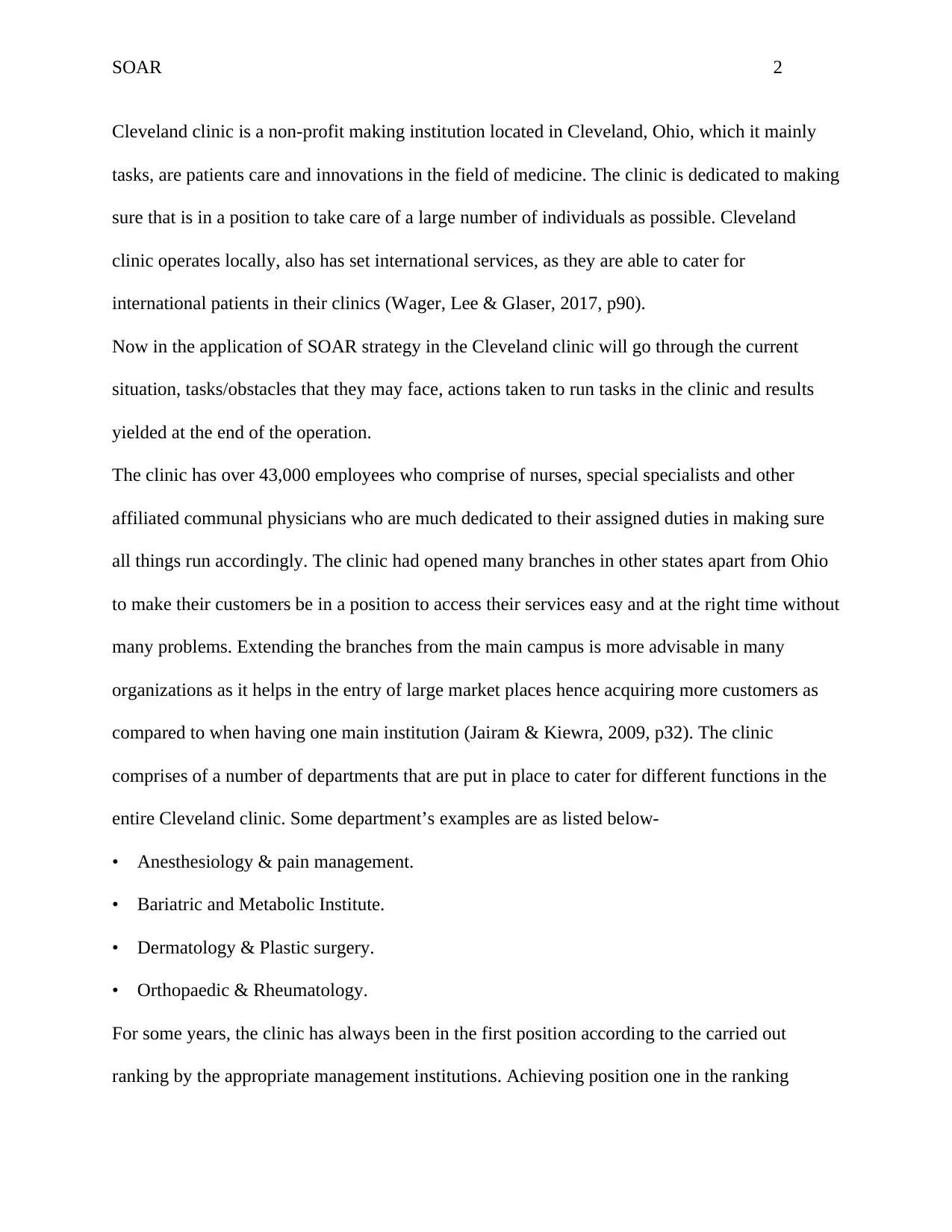
SOAR 2
Cleveland clinic is a non-profit making institution located in Cleveland, Ohio, which it mainly
tasks, are patients care and innovations in the field of medicine. The clinic is dedicated to making
sure that is in a position to take care of a large number of individuals as possible. Cleveland
clinic operates locally, also has set international services, as they are able to cater for
international patients in their clinics (Wager, Lee & Glaser, 2017, p90).
Now in the application of SOAR strategy in the Cleveland clinic will go through the current
situation, tasks/obstacles that they may face, actions taken to run tasks in the clinic and results
yielded at the end of the operation.
The clinic has over 43,000 employees who comprise of nurses, special specialists and other
affiliated communal physicians who are much dedicated to their assigned duties in making sure
all things run accordingly. The clinic had opened many branches in other states apart from Ohio
to make their customers be in a position to access their services easy and at the right time without
many problems. Extending the branches from the main campus is more advisable in many
organizations as it helps in the entry of large market places hence acquiring more customers as
compared to when having one main institution (Jairam & Kiewra, 2009, p32). The clinic
comprises of a number of departments that are put in place to cater for different functions in the
entire Cleveland clinic. Some department’s examples are as listed below-
• Anesthesiology & pain management.
• Bariatric and Metabolic Institute.
• Dermatology & Plastic surgery.
• Orthopaedic & Rheumatology.
For some years, the clinic has always been in the first position according to the carried out
ranking by the appropriate management institutions. Achieving position one in the ranking
Cleveland clinic is a non-profit making institution located in Cleveland, Ohio, which it mainly
tasks, are patients care and innovations in the field of medicine. The clinic is dedicated to making
sure that is in a position to take care of a large number of individuals as possible. Cleveland
clinic operates locally, also has set international services, as they are able to cater for
international patients in their clinics (Wager, Lee & Glaser, 2017, p90).
Now in the application of SOAR strategy in the Cleveland clinic will go through the current
situation, tasks/obstacles that they may face, actions taken to run tasks in the clinic and results
yielded at the end of the operation.
The clinic has over 43,000 employees who comprise of nurses, special specialists and other
affiliated communal physicians who are much dedicated to their assigned duties in making sure
all things run accordingly. The clinic had opened many branches in other states apart from Ohio
to make their customers be in a position to access their services easy and at the right time without
many problems. Extending the branches from the main campus is more advisable in many
organizations as it helps in the entry of large market places hence acquiring more customers as
compared to when having one main institution (Jairam & Kiewra, 2009, p32). The clinic
comprises of a number of departments that are put in place to cater for different functions in the
entire Cleveland clinic. Some department’s examples are as listed below-
• Anesthesiology & pain management.
• Bariatric and Metabolic Institute.
• Dermatology & Plastic surgery.
• Orthopaedic & Rheumatology.
For some years, the clinic has always been in the first position according to the carried out
ranking by the appropriate management institutions. Achieving position one in the ranking
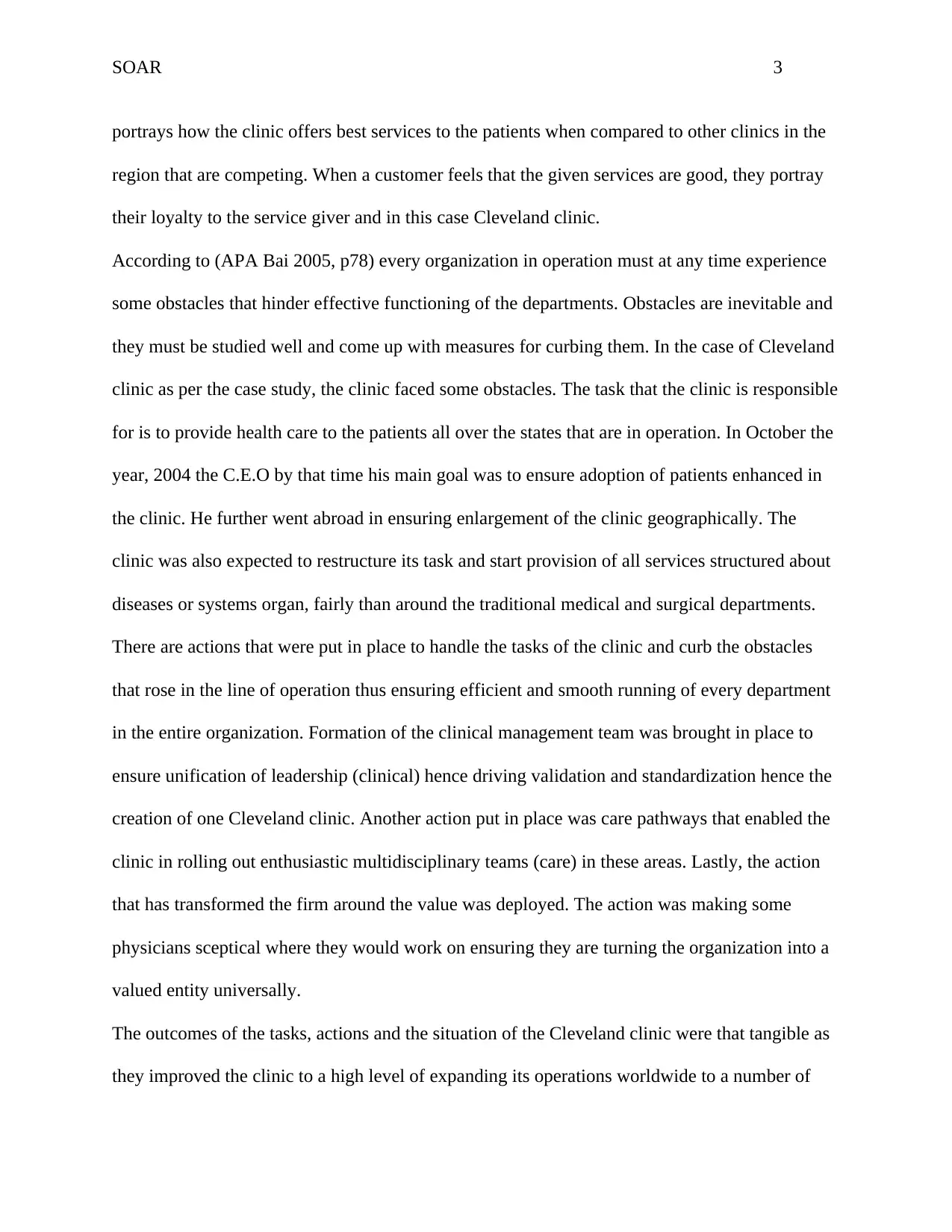
SOAR 3
portrays how the clinic offers best services to the patients when compared to other clinics in the
region that are competing. When a customer feels that the given services are good, they portray
their loyalty to the service giver and in this case Cleveland clinic.
According to (APA Bai 2005, p78) every organization in operation must at any time experience
some obstacles that hinder effective functioning of the departments. Obstacles are inevitable and
they must be studied well and come up with measures for curbing them. In the case of Cleveland
clinic as per the case study, the clinic faced some obstacles. The task that the clinic is responsible
for is to provide health care to the patients all over the states that are in operation. In October the
year, 2004 the C.E.O by that time his main goal was to ensure adoption of patients enhanced in
the clinic. He further went abroad in ensuring enlargement of the clinic geographically. The
clinic was also expected to restructure its task and start provision of all services structured about
diseases or systems organ, fairly than around the traditional medical and surgical departments.
There are actions that were put in place to handle the tasks of the clinic and curb the obstacles
that rose in the line of operation thus ensuring efficient and smooth running of every department
in the entire organization. Formation of the clinical management team was brought in place to
ensure unification of leadership (clinical) hence driving validation and standardization hence the
creation of one Cleveland clinic. Another action put in place was care pathways that enabled the
clinic in rolling out enthusiastic multidisciplinary teams (care) in these areas. Lastly, the action
that has transformed the firm around the value was deployed. The action was making some
physicians sceptical where they would work on ensuring they are turning the organization into a
valued entity universally.
The outcomes of the tasks, actions and the situation of the Cleveland clinic were that tangible as
they improved the clinic to a high level of expanding its operations worldwide to a number of
portrays how the clinic offers best services to the patients when compared to other clinics in the
region that are competing. When a customer feels that the given services are good, they portray
their loyalty to the service giver and in this case Cleveland clinic.
According to (APA Bai 2005, p78) every organization in operation must at any time experience
some obstacles that hinder effective functioning of the departments. Obstacles are inevitable and
they must be studied well and come up with measures for curbing them. In the case of Cleveland
clinic as per the case study, the clinic faced some obstacles. The task that the clinic is responsible
for is to provide health care to the patients all over the states that are in operation. In October the
year, 2004 the C.E.O by that time his main goal was to ensure adoption of patients enhanced in
the clinic. He further went abroad in ensuring enlargement of the clinic geographically. The
clinic was also expected to restructure its task and start provision of all services structured about
diseases or systems organ, fairly than around the traditional medical and surgical departments.
There are actions that were put in place to handle the tasks of the clinic and curb the obstacles
that rose in the line of operation thus ensuring efficient and smooth running of every department
in the entire organization. Formation of the clinical management team was brought in place to
ensure unification of leadership (clinical) hence driving validation and standardization hence the
creation of one Cleveland clinic. Another action put in place was care pathways that enabled the
clinic in rolling out enthusiastic multidisciplinary teams (care) in these areas. Lastly, the action
that has transformed the firm around the value was deployed. The action was making some
physicians sceptical where they would work on ensuring they are turning the organization into a
valued entity universally.
The outcomes of the tasks, actions and the situation of the Cleveland clinic were that tangible as
they improved the clinic to a high level of expanding its operations worldwide to a number of
⊘ This is a preview!⊘
Do you want full access?
Subscribe today to unlock all pages.

Trusted by 1+ million students worldwide
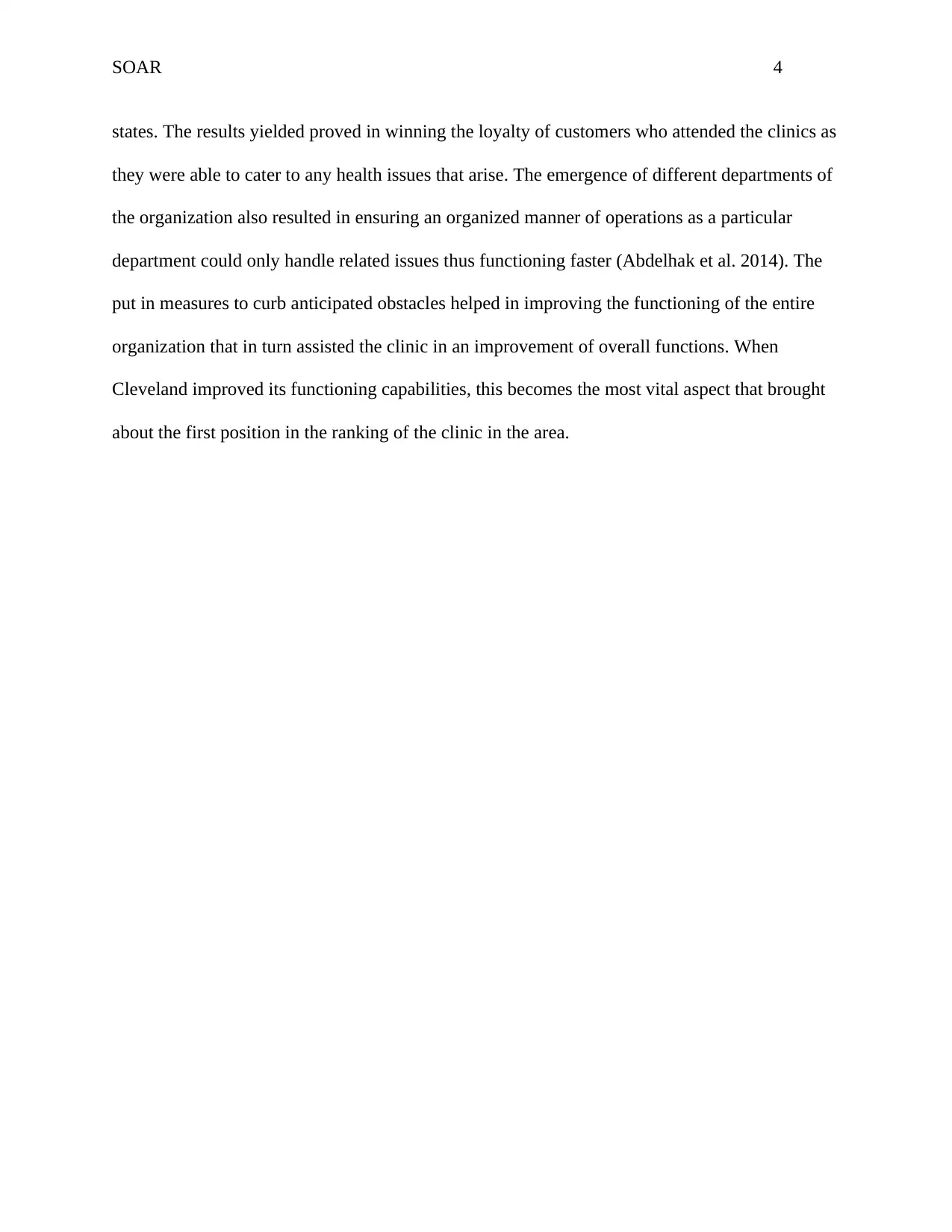
SOAR 4
states. The results yielded proved in winning the loyalty of customers who attended the clinics as
they were able to cater to any health issues that arise. The emergence of different departments of
the organization also resulted in ensuring an organized manner of operations as a particular
department could only handle related issues thus functioning faster (Abdelhak et al. 2014). The
put in measures to curb anticipated obstacles helped in improving the functioning of the entire
organization that in turn assisted the clinic in an improvement of overall functions. When
Cleveland improved its functioning capabilities, this becomes the most vital aspect that brought
about the first position in the ranking of the clinic in the area.
states. The results yielded proved in winning the loyalty of customers who attended the clinics as
they were able to cater to any health issues that arise. The emergence of different departments of
the organization also resulted in ensuring an organized manner of operations as a particular
department could only handle related issues thus functioning faster (Abdelhak et al. 2014). The
put in measures to curb anticipated obstacles helped in improving the functioning of the entire
organization that in turn assisted the clinic in an improvement of overall functions. When
Cleveland improved its functioning capabilities, this becomes the most vital aspect that brought
about the first position in the ranking of the clinic in the area.
Paraphrase This Document
Need a fresh take? Get an instant paraphrase of this document with our AI Paraphraser
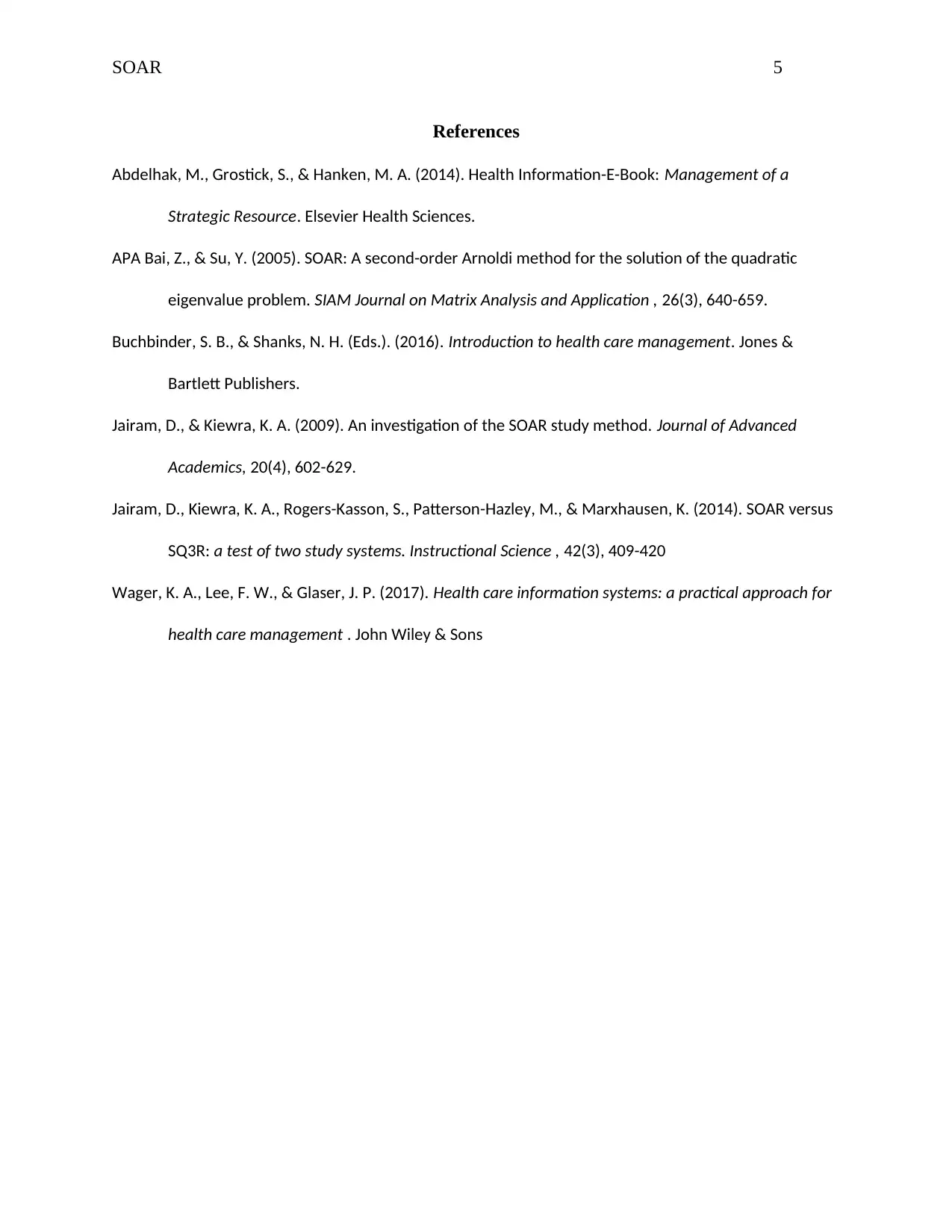
SOAR 5
References
Abdelhak, M., Grostick, S., & Hanken, M. A. (2014). Health Information-E-Book: Management of a
Strategic Resource. Elsevier Health Sciences.
APA Bai, Z., & Su, Y. (2005). SOAR: A second-order Arnoldi method for the solution of the quadratic
eigenvalue problem. SIAM Journal on Matrix Analysis and Application , 26(3), 640-659.
Buchbinder, S. B., & Shanks, N. H. (Eds.). (2016). Introduction to health care management. Jones &
Bartlett Publishers.
Jairam, D., & Kiewra, K. A. (2009). An investigation of the SOAR study method. Journal of Advanced
Academics, 20(4), 602-629.
Jairam, D., Kiewra, K. A., Rogers-Kasson, S., Patterson-Hazley, M., & Marxhausen, K. (2014). SOAR versus
SQ3R: a test of two study systems. Instructional Science , 42(3), 409-420
Wager, K. A., Lee, F. W., & Glaser, J. P. (2017). Health care information systems: a practical approach for
health care management . John Wiley & Sons
References
Abdelhak, M., Grostick, S., & Hanken, M. A. (2014). Health Information-E-Book: Management of a
Strategic Resource. Elsevier Health Sciences.
APA Bai, Z., & Su, Y. (2005). SOAR: A second-order Arnoldi method for the solution of the quadratic
eigenvalue problem. SIAM Journal on Matrix Analysis and Application , 26(3), 640-659.
Buchbinder, S. B., & Shanks, N. H. (Eds.). (2016). Introduction to health care management. Jones &
Bartlett Publishers.
Jairam, D., & Kiewra, K. A. (2009). An investigation of the SOAR study method. Journal of Advanced
Academics, 20(4), 602-629.
Jairam, D., Kiewra, K. A., Rogers-Kasson, S., Patterson-Hazley, M., & Marxhausen, K. (2014). SOAR versus
SQ3R: a test of two study systems. Instructional Science , 42(3), 409-420
Wager, K. A., Lee, F. W., & Glaser, J. P. (2017). Health care information systems: a practical approach for
health care management . John Wiley & Sons
1 out of 5
Related Documents
Your All-in-One AI-Powered Toolkit for Academic Success.
+13062052269
info@desklib.com
Available 24*7 on WhatsApp / Email
![[object Object]](/_next/static/media/star-bottom.7253800d.svg)
Unlock your academic potential
Copyright © 2020–2025 A2Z Services. All Rights Reserved. Developed and managed by ZUCOL.





